The war on lice
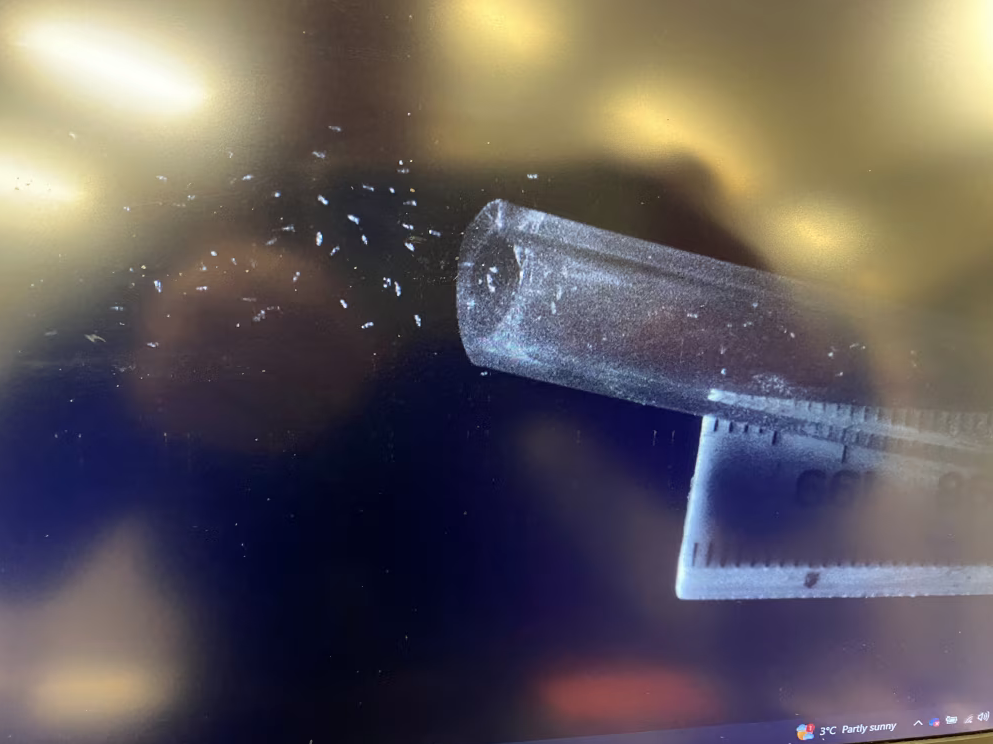
Technology is opening up a number of potential fronts in the struggle to keep farmed fish lice-free
Early warning could help salmon farmers take timely action to reduce sea lice numbers before their stock becomes infested with the parasites.
Clearly, assessing the levels of sea lice by counting the lice attached to salmon in a pen will only flag up the problem once it has already been established. Assessing the number of free swimming lice is difficult, however – for the human eye, anyway.
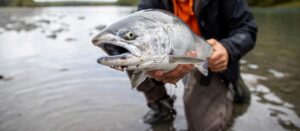
Coho salmon
Two current initiatives involve the use of advanced underwater cameras, combined with artificial intelligence (AI), to see whether technology could provide an earlier warning of sea lice numbers.
In its e-Lice project, Norwegian research institute Akvaplan-niva and partners are using advanced sensors and AI to detect and quantify salmon lice in the water column. October was the start of the first experiment in the project, testing the underwater imager UVP6 and developing an algorithm to classify the lice.
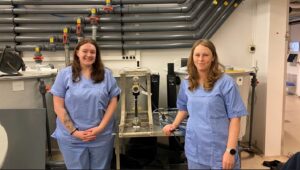
Ragnhild Pettersen from Akvaplan-niva and Lise-Merete Vågø at VESO Aqualab
The institute is working with VESO Aqualab, a commercial testing facility in Norway; French technology business Hydroptic, which developed the sensors; Nova Sea, Kongsberg Discovery; and MP Consulting.
The initial experiment took place at VESO Aqualab’s facility. Sea lice eggs collected from a local slaughterhouse were hatched and the lice larvae in the nauplius stage – the initial free swimming stage before developing into the copepodids that can infect fish – were released into tanks in a high concentration.
Over 15 days, the sensors recorded thousands of images of lice in both the nauplius and copepodid stages to be used as the basis for developing an algorithm through machine learning, so that the system can detect lice automatically.
Akvaplan-niva explains: “The objects imaged by the UVP6 can be biotic (zooplankton and fish larvae) or abiotic (particles) in nature. Given the diversity of particles (for example, detritus) and other co-occurring zooplankton in the water, it is important that free-swimming stages of salmon lice are detected and classified correctly. To meet this challenge, we developed artificial intelligence and computer vision-based algorithms to automatically detect and classify the objects imaged by the UVP6 in real-time.”
The institute says that the algorithm should detect sea lice with more than 91% accuracy. The next step will be to implement the UVP6 in a mooring that is being deployed and tested in the field in Tromsø. It will then be deployed in a strategic location to detect and quantify free swimming salmon lice in a Norwegian fjord.
Trude Borch, Senior Scientist at Akvaplan-niva, says: “There has been extensive work going on before and after the Christmas holidays on mechanical and electronics integration and testing of the mooring equipment and sensor (UVP6) that will be applied… the first field deployment and technical testing will not take place before the end of January.”
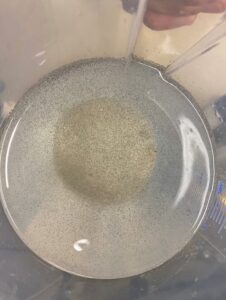
Lice density – photo: Ragnhild Pettersen
Holographic solutions
Meanwhile in Scotland, a team of researchers are also looking at how to create an early lice warning system based on holographic 3D imaging, machine learning and AI.
Led by experts in engineering and digital holography from the University of Aberdeen, alongside the Scottish Association for Marine Science (SAMS), the project received a funding boost of more than £538,000 from partners including the UK Seafood Innovation Fund and the Sustainable Aquaculture Innovation Centre.
Electronics business Hi-Z 3D, seafood producer Mowi, the Scottish Environment Protection Agency and the Scottish Government’s Marine Directorate are also supporting the initiative.
Using advanced underwater holographic cameras – developed at the University of Aberdeen – and AI-based automated image identification technology, the system would enable researchers to identify the natural presence and abundance of sea lice in the ocean, while also assisting fish farmers with rapid sea lice detection and effective management at Scottish salmon farms.
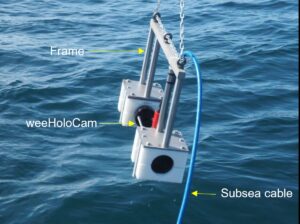
Deployment of weeHoloCam in the North Sea in June 2021
Currently, the most common way of testing for the parasite is to collect water samples to be analysed in a lab under a microscope, which can take several days to return results.
Compared to standard cameras and 2D photography, digital holography has significant advantages when used for microorganisms, the researchers say. The holographic camera can instantaneously record a volume of water and extract high-resolution images of the various particles present in the water. One hologram, therefore, can provide a set of data equivalent to thousands of standard photographic images.
Distinguishing sea lice from other zooplankton species has been compared to looking for a needle in a haystack, which is where the AI will come in. The system will be trained with thousands of holographic images of sea lice, recorded in the lab at SAMS, to support the process of identifying sea lice when the tool is deployed.
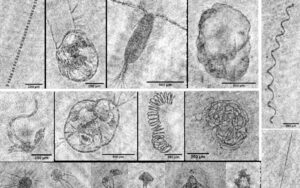
Plankton images from North Sea deployment
Dr Thangavel Thevar from the University of Aberdeen’s School of Engineering says: “The type of camera being used in this project was first developed for the identification of marine organisms and microparticles in the ocean. However, as it provides an accurate reflection of the different species present in the water, we saw an opportunity for the tool to be used to support the aquaculture sector with fish health management.
“The holographic imaging technology will be supported by AI and machine learning, which will help with the identification and cut processing time significantly. A major element of the project is to train the tool to recognise sea lice over other species. The images gathered over the next 18 months will help us to create the baseline for future analysis.”
SAMS has set up a dedicated sea lice hatchery for the project and will be supplying sample images that will be used as a starting point for the imaging tool. Digitally labelled holographs will be fed into the system to help train it to separate sea lice from other plankton species.
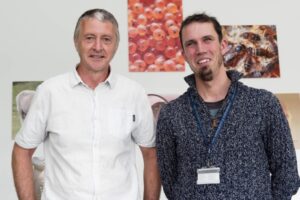
Nick Robinson and Diego Robledo
Gene editing insights
Different species of salmon have differing degrees of resistance to sea lice. The parasites are much less of a problem for the Pacific species, coho and pink salmon than for Atlantic salmon.
Scientists from Norwegian research institute Nofima have been investigating the genetic basis for these differences. Their research, involving gene editing, has led to the creation of a guide that could help researchers in animal genetics generally.
Australian Nick Robinson and Diego Robledo, from Spain, are both scientists with Nofima who have been working at the University of Edinburgh’s Roslin Institute. Together with colleagues from Nofima, the University of Edinburgh and Deakin University in Australia, they have produced “A guide to assess the use of gene editing in aquaculture.”
As the guide explains: “Gene editing using CRISPR-Cas9 [which has become the standard technology for gene editing] has the potential to transform aquaculture by improving animal welfare, nutritional attributes and farming efficiency, with benefits for environmental sustainability. However, gene editing also poses risks of harm via side effects on other important traits or genetic introgression into wild populations.”
Public acceptance of genetic research will depend, the authors say, on ensuring that the risks and benefits of any given piece of research have been thoroughly examined and understood. The guide sets out a framework to do this, which could be applied to genetic research across a range of fish and animal species.
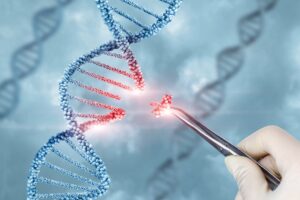
Gene editing
Robinson stresses that the Nofima research involves small, targeted changes to the salmon’s own genes, not splicing genes from different species together.
In an article last year for Nofima, he said: “Our genomic research is helping us to understand which genes are involved in providing resistance against sea lice in the Pacific salmon species. The next step in our project is to test the function of these genes in Atlantic salmon using gene editing… [in 2024] we will be ready to introduce gene-edited Atlantic salmon to sea lice in a closed biosecure facility.
“We want to see whether small and precise changes disrupting the function of these genes can cause the immune cells in Atlantic salmon to encapsulate the lice and kill them, as occurs in coho, or to prevent attachment as occurs in pink salmon.”
The research could help Atlantic salmon and the aquaculture industry, but the insights already gained could have even wider benefits.
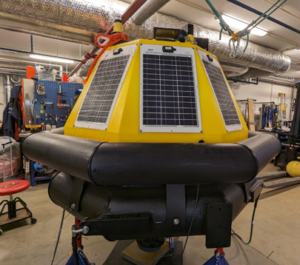
SAIV AS APB5 mooring
Gentler treatment
Mechanical treatments for sea lice can be effective in removing the lice and are not reliant chemicals that could get into the environment. The process itself, however, can cause stress to the salmon and damage their natural defences, leaving them open to a variety of threats, from heart failure to bacterial infection.
The companies developing mechanical treatments and pumping systems to transport the fish are increasingly focused on ways to minimise stress.
Lars Georg Backer, General Manager of Flatsetsund Engineering AS, said back in 2020: “That fish die during delousing is a reputational problem for the industry. In addition, the economy is bad for the farmers. Low fish mortality and other losses in production are important for efficient resource utilisation and the economy of the industry. We are concerned about this.”
He was speaking as the company launched the latest version of its FLS delousing system. The FLS CALIGUS delouser has undergone extensive testing in the aquaculture industry. The company says the solution is showing great results and proving that it can handle the fish gently.
Tests have shown that the FLS system, which can be installed on wellboats, can achieve an output of 300 to 400 tonnes per hour and 90% to 100% removal of lice, with mortality rates for the salmon of just 0.1%.
The siphon principle, where the fish is collected and delivered at the same level, means that the pump pressure is all the way down to 0.35 bar. The combination of a gentle ejector and low pump pressure results in little damage to the fish, low mortality and low energy consumption, the company says.
Laser vision
Shooting sea lice with laser beams that kill the parasites without harming the fish sounds like the stuff of sci-fi, but it has already been successfully deployed in salmon farms.
North Norwegian fish farmer Nordlaks says it is so pleased with laser technology in tackling lice that it has decided to invest in up to 50 machines.
Nordlaks says it has tested the use of lice lasers from Stingray Marine Solutions at two locations: Havfarmen outside Hadseløya and Litjevika in Dyrøy municipality.
The lasers (pictured) are lowered into the cages, where the beams are directed at lice on the salmon.
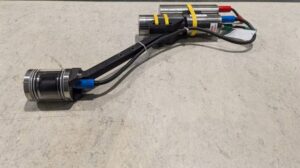
The underwater vision profiler, UVP6
This kills the lice, but does not harm the salmon, which can remain in their natural environment and are not stressed.
Results after use at the two locations have been sensational, says the company. Bjarne Johansen, Manager at Nordlaks Havbruk, said at the end of last year: “At Havfarmen, which is our largest facility, we have managed without delousing this year.
“We released fish this summer and this year there have been extra salmon lice due to the hot summer. Nevertheless, we have managed to keep the lice numbers in check.”
In Litjevika, too, there was no need for delousing after the lasers were installed. After the success at Havfarmen and Litjevika, Nordlaks has now invested in a further 50 lice lasers from Stingray.
Some 12 machines were deployed in 2022 and a further 20 last year.
Nordlaks said the lasers will be installed at five to six new facilities and will result in lice lasers being used on 20% to 30% of Nordlaks’ production.
Fatal attraction
Light of a different kind could be used in future to attract and trap sea lice swimming in and around pens. That is an enticing possibility anyway, suggested by research carried out by scientists at Norwegian research centre Sintef.
A paper entitled Responses and preferences of salmon louse (Lepeophtheirus salmonis Krøyer 1836) copepodids to underwater artificial light sources (Nordtug, Kvæstad and Hagemann, published in Aquaculture, February 2021) used automated image processing to track the behaviour of sea louse copepodids in a lab tank.
The study found that: “Copepodids always moved towards the light source even at low light intensities… within a broad spectrum of visible light as well as near-UV. It is therefore plausible that subsea light sources frequently used in salmon farming under certain conditions can attract salmon lice copepodids and increase infection pressure.”
The researchers found that the lice preferred white or blue light to green, red or UV light, but UVA light alone was able to attract the lice.
More recently, the team has performed field experiments looking at patterns of diel vertical migration (the synchronised movement of zooplankton and fish up and down in the water column over a daily cycle) using a custom-made mesocosm (enclosed environment).
Combining attraction to light with an effective mechanism to trap and kill the lice, without impacting on the welfare of the salmon, will present a further challenge.

